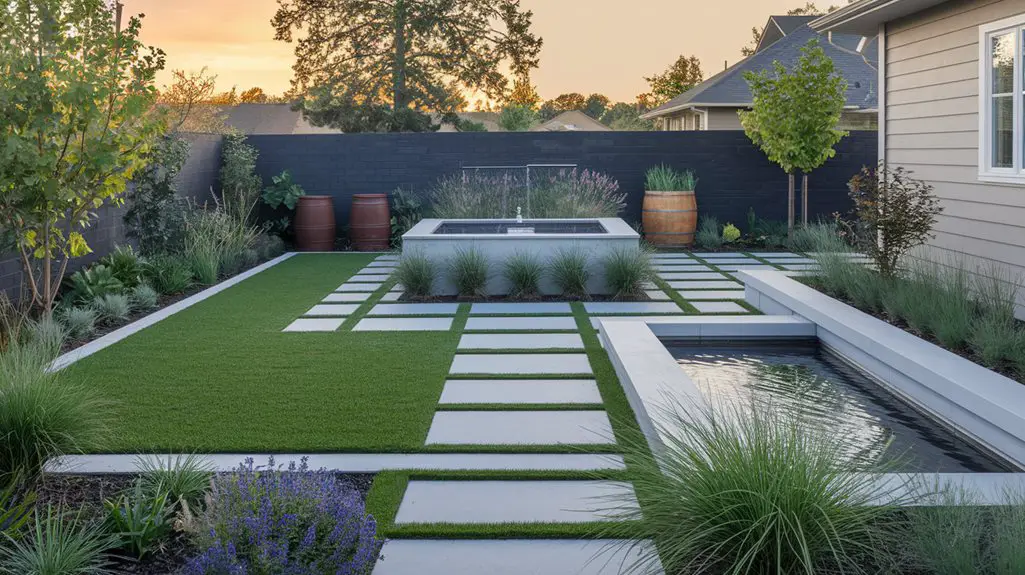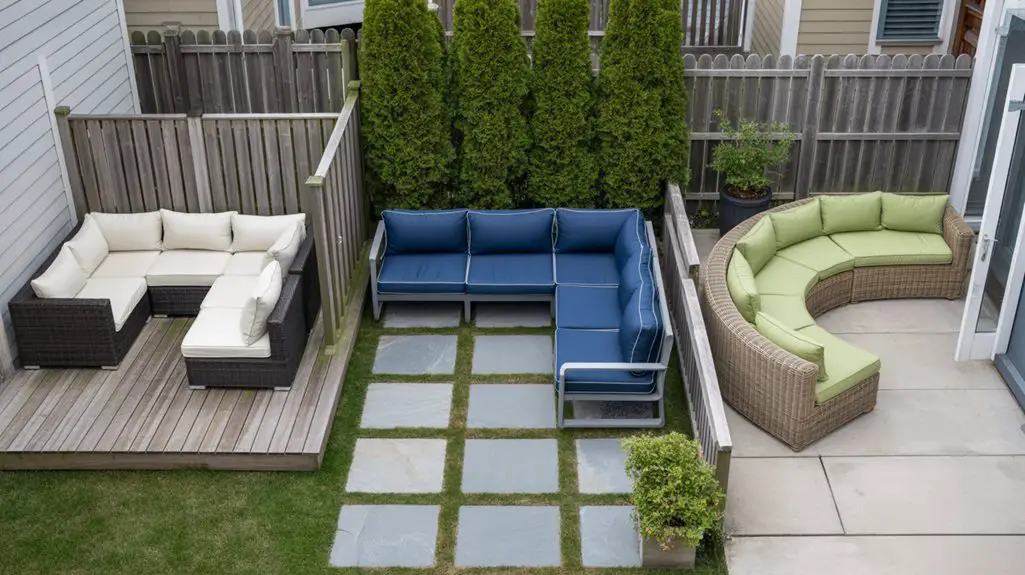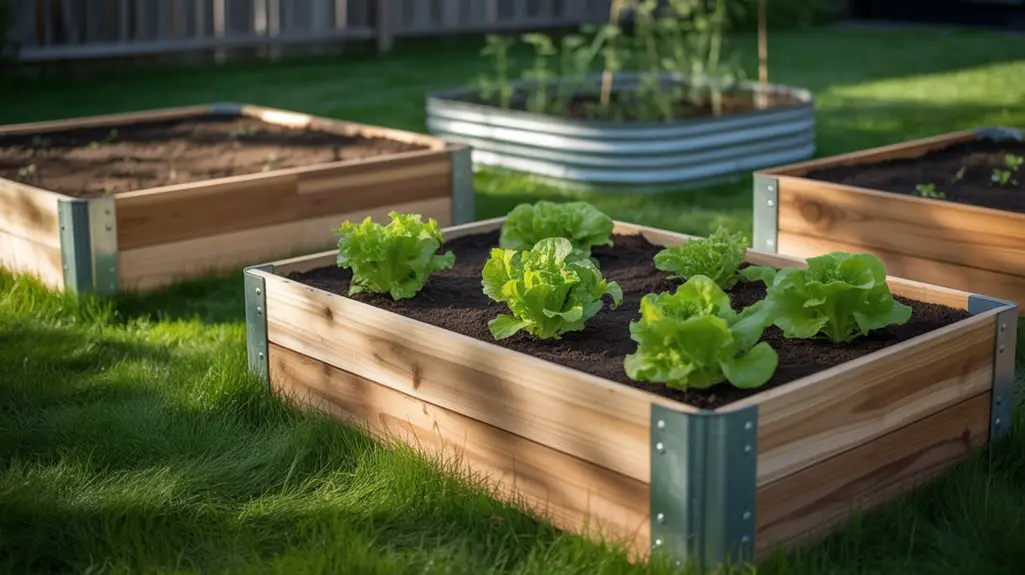While water bills rise and reservoirs fall, your backyard holds untapped potential for conservation. You’ll find that sustainable design isn’t just environmentally responsible—it’s financially savvy too. Modern rainwater systems can transform your outdoor space into an eco-sanctuary that works with nature rather than against it. From underground cisterns to wildlife-friendly collection points, these five designs offer practical solutions for any yard size or geography. The perfect system awaits your discovery.
Modern Rain Garden Retreat With Underground Cistern System
While traditional gardens merely showcase plants, a modern rain garden retreat transforms your backyard into a dynamic ecosystem that captures, stores, and utilizes rainwater.
The centerpiece of this design is an underground cistern system that collects runoff from your roof and hardscapes. You’ll position native moisture-loving plants in strategic depressions, creating a natural filtration system that purifies water before it enters the cistern. This setup reduces municipal water usage by up to 60%.
Connect your cistern to drip irrigation lines for efficient garden watering during dry spells. Add permeable pathways and decorative rock arrangements that direct water flow while creating visual interest.
Stone benches nestled among rain-tolerant sedges and rushes provide peaceful spots for contemplation. Incorporating rainwater harvesting techniques not only enhances the beauty of your landscape but also promotes sustainability and conservation efforts.
You’re not just creating beauty—you’re participating in the water cycle, supporting local wildlife, and building climate resilience.
Multi-Tier Cascading Rain Barrel Design for Sloped Yards

If your property features a natural slope, you can transform this topographic challenge into an innovative water-harvesting opportunity with a multi-tier cascading rain barrel system. This design leverages gravity to distribute collected rainwater across your landscape while creating a striking visual element. Additionally, implementing effective rainwater filtration can enhance the quality of the collected water, making it suitable for various uses.
| Tier Level | Container Type | Primary Function |
|---|---|---|
| Top | 55-gal barrel | Main collection |
| Upper-mid | Rain chain | Water transport |
| Middle | Planter barrel | Filtration |
| Lower-mid | Storage tank | Irrigation reserve |
| Bottom | Overflow basin | Groundwater recharge |
Position the highest barrel beneath your gutter downspout, connecting subsequent tiers with small pipes or decorative chains. Each tier can serve multiple purposes—watering plants, creating habitat, and preventing erosion—while excess water flows naturally downward, mimicking nature’s own watershed systems.
Edible Landscape With Integrated Drip-Irrigation Rainwater Network

Transform your conventional yard into a productive oasis by installing an integrated drip-irrigation rainwater network throughout your edible landscape. Connect gravity-fed water lines from your rain barrels to strategic zones where fruit trees, berry bushes, and vegetable beds thrive without wasting a drop.
Position water-loving herbs like mint and watercress near barrel overflow areas, while drought-tolerant rosemary and sage can flourish at higher, drier points. You’ll cut water bills while creating habitat corridors for pollinators and beneficial insects. Additionally, consider creative ways to collect rainwater to enhance your system’s efficiency and sustainability.
Use simple pressure-compensating drippers for consistent flow even on uneven terrain. Mulch heavily around all irrigation lines to prevent evaporation and suppress weeds.
For winter protection in colder climates, install quick-disconnect valves that allow you to drain the system before freezing temperatures arrive.
Zen-Inspired Water Conservation Sanctuary With Permeable Surfaces
Create a personal sanctuary that honors water as sacred by designing a Zen-inspired retreat where every element serves both aesthetic and ecological purposes. Install permeable walkways using spaced stone pavers, crushed granite, or pervious concrete to allow rainwater infiltration instead of runoff. Your sanctuary’s focal point might feature a small recirculating water feature powered by solar energy. Additionally, consider integrating compact rainwater systems that can efficiently collect and utilize rainwater in small backyards.
| Element | Purpose | Materials |
|---|---|---|
| Rain garden | Captures runoff | Native sedges, rushes |
| Dry creek bed | Directs overflow | River rock, pebbles |
| Meditation area | Human sanctuary | Permeable pavers |
Incorporate drought-tolerant plants like Japanese maples, dwarf conifers, and ornamental grasses that require minimal irrigation once established. These plants create visual harmony while conserving water, demonstrating that sustainability and tranquility can beautifully coexist in your backyard ecosystem.
Wildlife-Friendly Habitat With Strategic Rainwater Collection Points
While designing your backyard ecosystem, consider how strategic rainwater collection points can simultaneously serve local wildlife and conserve precious water resources.
Position shallow basins at varying heights—ground level for hedgehogs and reptiles, elevated platforms for birds and butterflies—all connected to your main collection system.
Install micro-ponds with gently sloping edges where amphibians can safely enter and exit. These living water features filter naturally through aquatic plants while providing critical habitat.
You’ll find native species quickly colonizing these moisture-rich zones.
Connect your rain barrels to these wildlife stations using gravity-fed irrigation. During dry spells, release collected water to maintain these microhabitats.
Choose permeable pathways between collection points to maximize groundwater recharge. Regular maintenance and system care practices are essential to ensure these designs function efficiently and benefit local wildlife.
The result: a vibrant backyard that supports biodiversity while making every raindrop count in your sustainable landscape design.
Conclusion
By creating your own sustainable backyard with rainwater systems, you’ll join the growing movement of eco-conscious homeowners making a difference. Did you know that a properly designed rain garden can reduce stormwater runoff by up to 90%? As you reimagine your outdoor space, you’re not just conserving precious water resources—you’re creating vibrant habitat connections that nurture local ecosystems while bringing natural beauty right to your doorstep.




